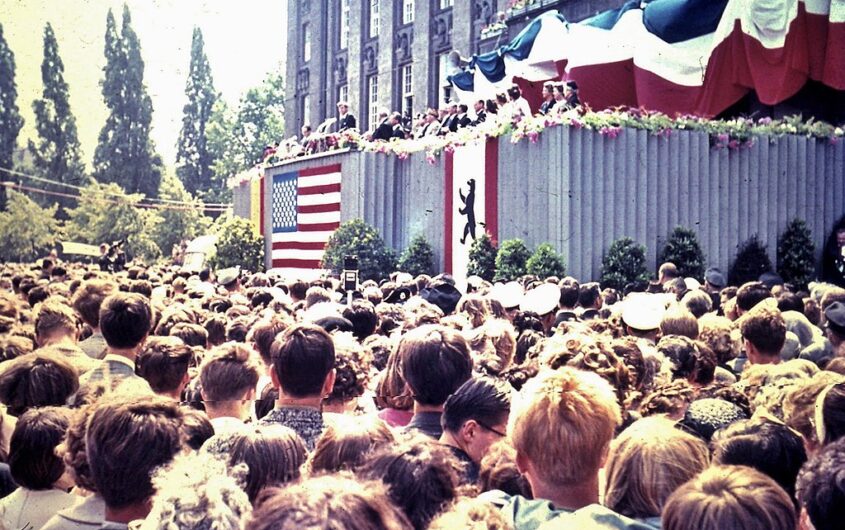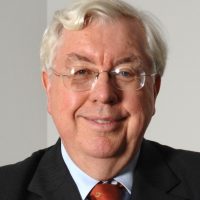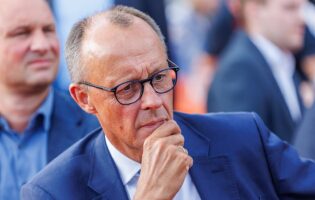
Friedrich-Karl Mohr via Wikimedia Commons
Kennedy’s “Ich bin ein Berliner”

John Kornblum
AGI Trustee
John Kornblum is a senior counselor at the international law firm Noerr LLP and a former U.S. ambassador to Germany. He is a member of the AGI Board of Trustees.
Courageous Ukraine has become the West Berlin of the 21st century
It has been 60 years since John F. Kennedy’s historic speech in Berlin. Today there is still much to learn from it, suggests the former American Ambassador in Germany. This article originally appeared in Der Tagesspiegel on June 26, 2023.
On June 26, Berliners commemorated the sixtieth anniversary of President John F. Kennedy’s historic “Ich bin ein Berliner” speech at the Schöneberger Rathaus. Kennedy’s 1963 Berlin visit is today remembered mostly for its emotional rhetoric and penetrating defense of freedom in Berlin which echoed around the world. But Kennedy came to Berlin with a much more pragmatic diplomatic strategy, which is often lost in the emotions of his Rathaus speech. His goals were first, to shore up support for a German government unnerved by what appeared to have been a weak American reaction to Russia building the Berlin Wall. But second, to suggest an active strategy based on Western strength and unity, combined with a pragmatic dialogue to reduce tensions in Europe, including in Berlin.
To understand Kennedy’s intentions, it is first important to recall that his emotional remarks in Schöneberg were only the first of two speeches that he delivered in Berlin on that day. The second came at the Free University in the leafy suburbs of western Berlin.
If the Rathaus speech came across as an ideological challenge to the Russians, the longer policy address delivered that afternoon in Dahlem turned out to be an amazingly pragmatic and prescient message for the future. Kennedy predicted exactly what ultimately happened—the reunification of Germany and Europe on the basis of Western strength and unity as the tools for change.
This second speech is nearly forgotten today, and that is a shame. Rather than offering excuses for not tearing down the Wall, Kennedy offered a strategic explanation for his toleration of the barbed wire as it was unrolled around the city. “We must face the facts as they are, not to involve ourselves in self-deception,” he said. “If we are to work for the future of the city, let us deal with the realities as they actually are, not as they might have been, and not as we wish they were.” Kennedy’s recipe for overcoming the “realities,” was based on a proposal for peaceful engagement with Russia the president had set forth in his “Strategy of Peace” address at the American University in Washington just two weeks earlier.
One attentive listener on that day in June was Berlin’s Governing Mayor Willy Brandt. Brandt’s strategist Egon Bahr stressed often in later years that Kennedy’s two June speeches in Washington and Berlin were an inspiration for Willy Brandt’s Ostpolitk—dialogue and change supported by a strong and unified NATO Alliance. Bahr in fact presented similar ideas at the Evangelical Academy in Tützing, Bavaria, less than a week after Kennedy’s visit.
The crises we were facing in 1963 seemed to be as intractable then as the tensions arising from Russia and China today.
Ironically, most of Kennedy’s advisors had been worried that both the American University speech and the President’s visit to Europe two weeks later could be taken as signs of weakness at a time when NATO and the West were very much under pressure. But confrontations in Berlin and Cuba had apparently convinced the President to step away from the aggressive approach to Russia that Kennedy himself had highlighted in his 1960 Presidential campaign.
His chief advisor, Theodore Sorensen, later reported that speech writers had played virtually no role in the text for the American University address. Kennedy had written it personally with great speed by hand. Sorensen added that he thought the resulting speech had been the best and most memorable address Kennedy delivered while President.
Even though Kennedy did not live to see the success of his new strategy, the plans he hatched in the three months between June and August 1963 rapidly bore practical results. His speeches in Washington and Berlin were quickly followed by an agreement with Russia on a global ban against nuclear testing, which was initialed on August 5, 1963. Kennedy’s tragic assassination soon followed, and his successor Lyndon Johnson became so bogged down in Vietnam that he could not carry Kennedy’s initiative much further. It would be eight long and dangerous years before East and West started talking seriously with each other again.
And most important for today’s generation, the crises we were facing in 1963 seemed to be as intractable then as the tensions arising from Russia and China today. In particular, the Warsaw Pact invasion to suppress democracy in Czechoslovakia in August 1968 was believed to have blocked any progress in Berlin or elsewhere for years to come.
But Richard Nixon and his national security advisor Henry Kissinger had other plans. Nixon strongly believed that only a conservative such as he could take the necessary steps towards Moscow which would make a reduction in tensions possible.
Today, just as sixty years ago, Kennedy’s recipe remains valid. For those who wish to understand the attraction of freedom, “Let them come to Kyiv.”
And he was right. But more importantly, when one reads the detailed preview of the Nixon/Kissinger détente policy, published as Nixon assumed office in 1970, the similarity of their ideas to the strategies of both Kennedy and Brandt literally jumps from the page. A key to the era of détente which Nixon and Brandt began for the West was Kennedy’s success in projecting both strength and flexibility during his 1963 visit to Berlin. Looking back on this era in his memoirs, Henry Kissinger concluded that Western solidarity in Berlin had been the key to solving the Cold War puzzle.
Today’s conflict in Ukraine is very similar to the confrontation in Berlin. Options for a peaceful settlement that protects Ukraine’s sovereignty and national territory are difficult to conceive, as were the arrangements which ultimately formed the basis for the Quadripartite Agreement on Berlin in 1971. Literally dozens of peace plans have been put forward by Western experts. But each fall short, blocked by the demands of the Russian aggressor for Ukrainian capitulation, just as the many solutions for the Berlin confrontation put together after the Wall was built were destined to fail.
But Kennedy’s efforts were not in vain. After his visit, a trip to Berlin became an important requirement for American leaders and politicians. One by one, they made pilgrimages to Berlin. Among them was Ronald Reagan, who in 1987 made the ultimate demand as he called on Soviet chairman Gorbachev simply to “tear down this wall.”
Happily, the vibrant and exciting city of Berlin has now become a different sort of attraction for visitors around the world. Its role as a beacon of freedom has been assumed by Kyiv. Courageous Ukraine has in fact become the West Berlin of the 21st century.
It is important for impatient politicians and think tankers who are busy concocting “solutions” to the conflict begun by Russia in Ukraine to understand that by standing firm, Ukraine’s brave people are creating the conditions for a satisfactory solution to the complex Russian puzzle, just as West Berliners did sixty years ago.
Today, just as sixty years ago, Kennedy’s recipe remains valid. For those who wish to understand the attraction of freedom, “Let them come to Kyiv.”









